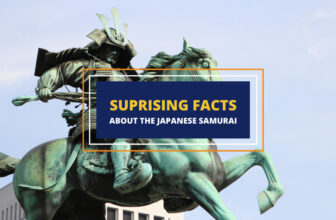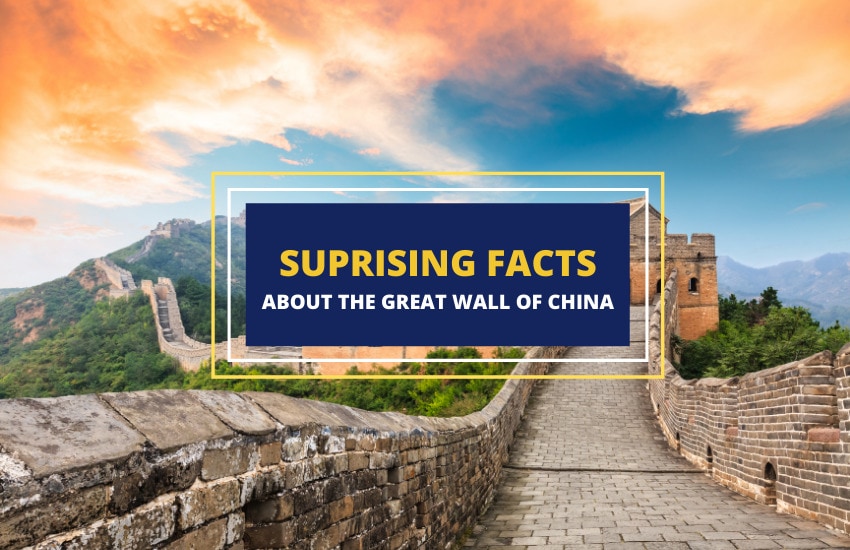
Table of Contents
The Great Wall of China was included in the list of UNESCO World Heritage Sites in 1987 even though large portions of it lie in ruins or are no longer there. It remains one of the world’s most astounding structures and is often praised as an exceptional feat of human engineering and ingenuity.
This ancient structure attracts millions of tourists each year. We all know that the scenery there can be breathtaking, but there are many other fascinating things to know about the fabled walls. For instance, who knew that grains of rice could be used when building a wall, and is it true that corpses were buried inside it?
Here are some extraordinary facts that you still likely don’t know about the Great Wall of China.
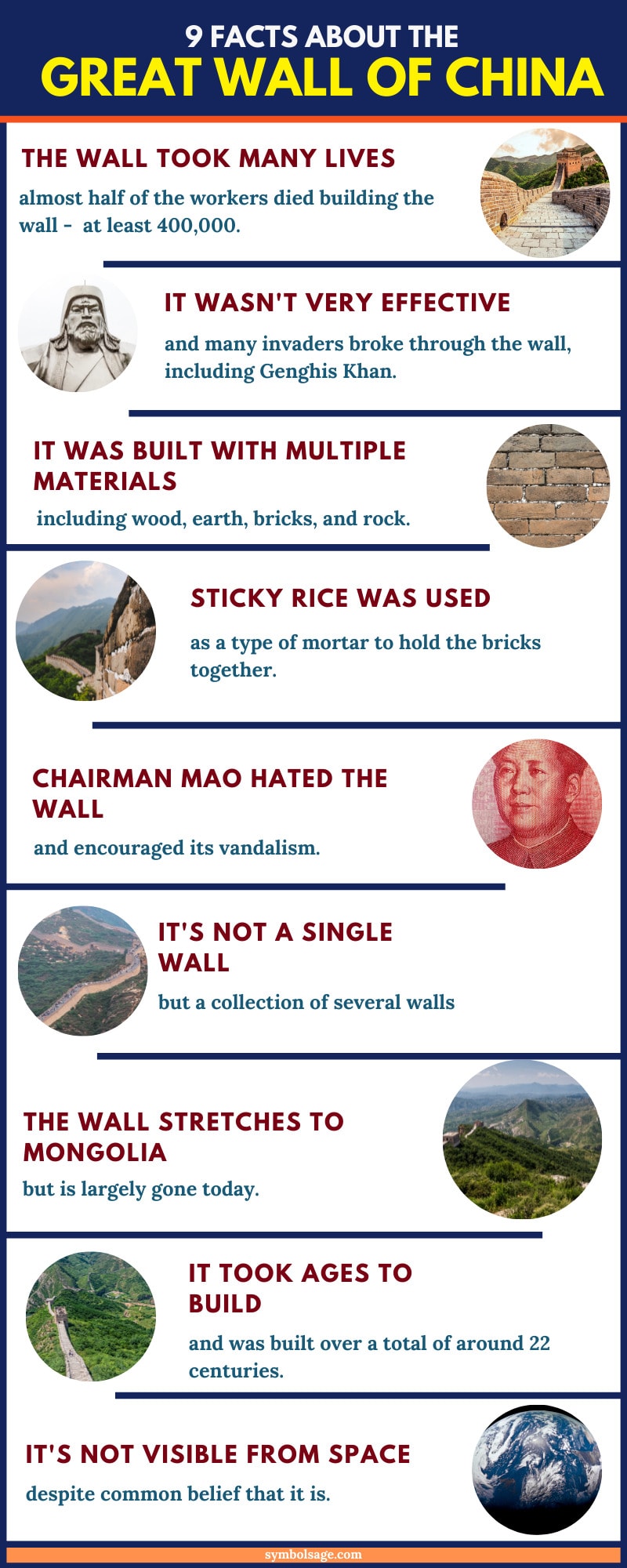
The Wall Took Many Lives
The Chinese Emperor Qin Shi Huang ordered the construction of the Great Wall in about 221 B.C. Truth be told, he didn’t start the wall from scratch but rather joined individual sections together that had already been constructed over millennia. Many died in this phase of its construction – perhaps as many as 400,000.
Soldiers forcefully recruited peasants, criminals, and captured enemy prisoners made up the immense workforce that numbered up to 1,000,000. During the Qin (221-207 BC) and Han (202 BC-220 AD) Dynasties, working on the wall was used as a heavy punishment for state offenders.
The people worked in horrific conditions, often going for days without food or water. Many had to obtain water from nearby rivers. The workers had very little clothing or shelter to protect them from the harsh weather conditions.
With such brutal working conditions, it is little wonder that almost half of the workers died. According to myths, the corpses were buried inside the wall, but there is no evidence yet that this truly happened.
It Wasn’t Very Effective
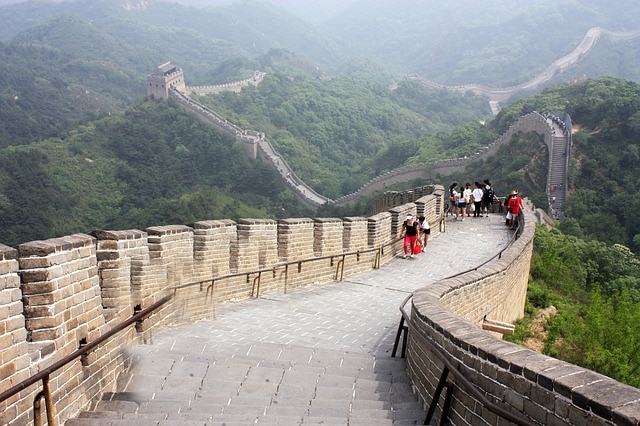
The Great Wall was originally built as a series of fortifications to protect China’s northern border from constant attacks by bandits and invaders – “northern barbarians”.
China is protected on the east side by the ocean, and the west by the desert but the north was vulnerable. Even though the wall was an impressive structure, it was far from being effective. The majority of enemies simply marched until they reached the wall’s end then went around. Some of them just forcibly took down vulnerable portions of the wall to get in.
However, a fearsome Mongolian leader, Genghis Khan, had a better way of conquering the great wall. His troops just scouted parts that had already collapsed and simply walked in, saving time and resources.
Kublai Khan broke through it in the 13th century too, and later, Altan Khan with tens of thousands of raiders. The lack of funding to maintain the wall caused many of these problems. Since it is extremely long, it would have been costly for the empire to keep the whole wall in great shape.
It Wasn’t Built with Just One Material
The wall is not uniform in structure but is rather a chain of different structures with gaps between. The construction of the wall depended on the building materials available in the immediate vicinity.
This method makes the wall different from one place to another. For instance, the original sections were built with hard-packed earth and wood. Later sections were built with rock such as granite or marble, and others with bricks. Some parts consist of natural terrain such as cliffs, while others are existing river dikes. Later, in the Ming dynasty, the emperors improved the wall by adding watchtowers, gates, and platforms. These later additions were mainly constructed from stone.
Rice Was Also Used to Build It
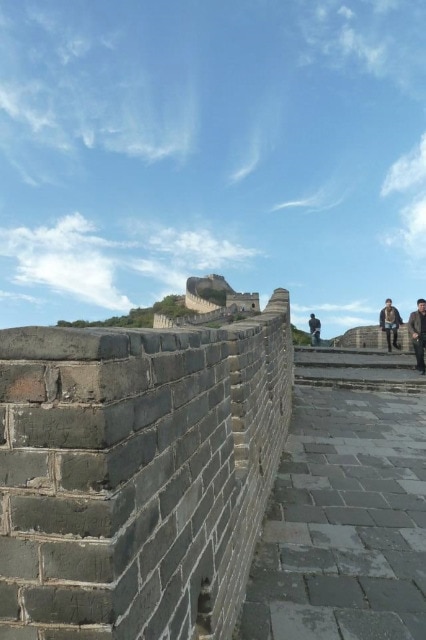
The mortar used between the rocks and bricks was mainly made with a mixture of lime and water. However, Chinese scientists have discovered that in some places, sticky rice had been added to the mix.
This is the first type of composite mortar in history, and it served to make the mortar stronger. The Ming dynasty emperors, who ruled China from 1368 to 1644, exclusively used this construction method and it was one of their greatest innovations.
Rice mortar was used for other structures as well such as temples and pagodas to strengthen them. The supply of rice for the mortar was often taken away from farmers. Since this way of building the wall stopped after the Ming dynasty collapsed, other parts of the wall were built differently going forwards.
The sections of wall that were built using the sticky rice mortar still hold up to this day. It is highly resistant to the elements, plant damage, and even earthquakes.
The Wall is Now Crumbling
Just like the fallen empires before it, the present Chinese government cannot keep this vast structure maintained because of its great length.
About a third of it is crumbling away, while only a fifth is in reasonable condition. 10 million tourists visit the wall every year. This huge number of tourists is wearing away the structure little by little.
From simply walking atop the wall to downright chipping off parts of it to set up tents and take as souvenirs, tourists are destroying the wall faster than it can be renovated.
Some of them leave graffiti and signatures that can cost a lot to remove. It is also impossible to remove them without taking away some material from the wall, causing it to deteriorate even faster.
Chairman Mao Hated It
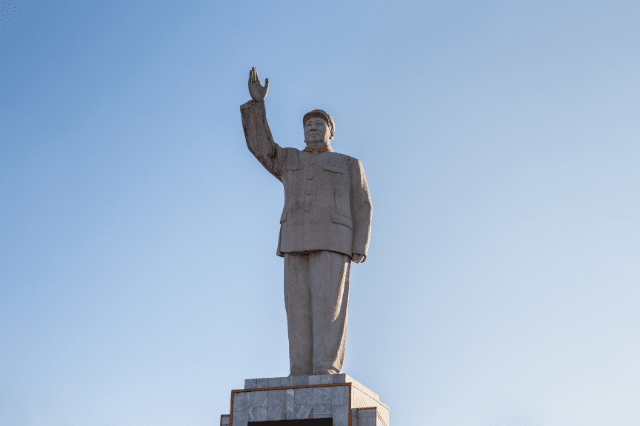
Chairman Mao Tse-tung encouraged his citizens to destroy the wall during his Cultural Revolution in the 1960s. This was because of his ideology that traditional Chinese beliefs and culture hold back their society. The wall, being a remnant of the past dynasties, was the perfect target for his propaganda.
He motivated the rural citizens to remove bricks from the wall and use them to build homes. Even today, farmers take bricks from it to build animal pens and houses.
The mass destruction only stopped when Deng Xiaoping, Mao’s successor, halted the wall’s demolition and instead began to rebuild it, saying, “Love China, Restore the Great Wall!”
It’s the Birthplace of a Tragic Myth
There is a widespread myth in China about the wall. It tells a tragic story about Meng Jiang, a lady who was married to Fan Xiliang. Her husband was forced to work in extreme conditions on the wall. Meng longed for the presence of her spouse, so she decided to pay him a visit. Her happiness turned to grief when she arrived at her husband’s workplace.
Fan had died of fatigue and had been buried inside the wall. She was heartbroken and sobbed at all hours of the day and night. The spirits heard her sorrowful cry, and they caused the wall to crumble. She then retrieved her husbands’ bones to give him a proper burial.
It is Not a Single Line of Wall
Contrary to popular belief, the wall is not a single long line across China. It is, in reality, a collection of numerous walls. These walls used to be fortified by garrisons and soldiers.
There are parts of the wall that run parallel to each other, some are a single line just like we see in photos, and others are branching networks of walls that encompass multiple provinces.
The Wall Stretches to Mongolia
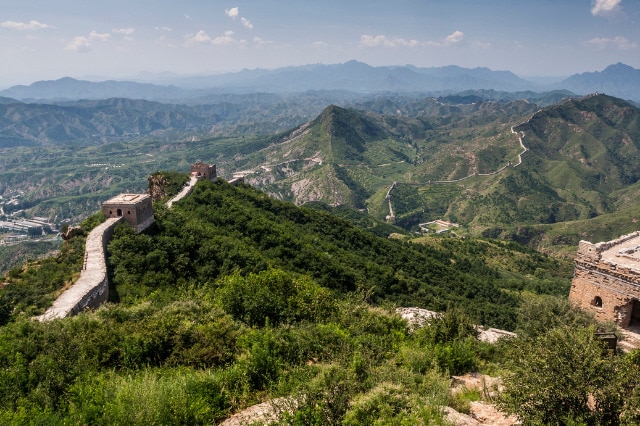
There is actually a Mongolian section of the wall that was thought to be gone until it was found a few years ago by a party of explorers led by William Lindesay. Lindesay learned about the Mongolian portion on a map sent to him by a friend in 1997.
It had stayed hidden even to the eyes of local Mongolians until Lindesay’s crew found it again in the Gobi Desert. The Mongolian section of the wall was just 100 km long (62 miles) and only about half a meter high in most places.
It is Both Old and Fairly New
Experts generally agree that many parts of the defensive wall are over 3,000 years old. It is said that the earliest walls that were meant to protect China were erected during (770–476 BCE) and the Warring States period (475–221 BCE).
The best-known and best-preserved sections are the product of a major building project that began around 1381 in the Ming Dynasty. These are the parts that were made with sticky rice mortar.
From Hushan in the east to Jiayuguan in the west, the Ming Great Wall stretched 5,500 miles (8,851.8 km). Many of its parts, including Badaling and Mutianyu in Beijing, Shanhaiguan in Hebei, and Jiayuguan in Gansu, have been restored and converted into tourist destinations.
These tourist-friendly portions are typically 400 to 600 years old. So, these parts are new compared to the worn-out parts of the wall that are already thousands of years old.
It Took Ages to Build
Even with a massive workforce, the Great Wall took many years of construction to be completed.
The defensive walls were constructed during numerous dynasties that spanned 22 centuries. The Great Wall as it stands now was mostly constructed by the Ming Dynasty, which spent 200 years building and rebuilding the Great Wall.
There is a Legend about the Souls on the Wall
Roosters are used as an aid to the lost spirits on the wall. Families carry roosters to the wall with the belief that their song can guide souls. This tradition was born out of the deaths that the construction of the wall has caused.
It’s Not Visible from Space
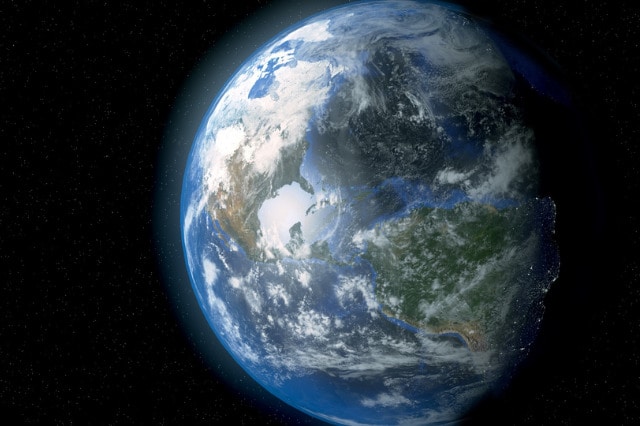
There is a common misconception that the wall is the only man-made object that’s visible from space. The Chinese government stood firm that this was the truth.
China’s first astronaut, Yang Liwei, proved them wrong when he was launched into space in 2003. He confirmed that the wall cannot be seen from space with the naked eye. After that, the Chinese spoke about rewriting the textbooks that perpetuate this myth.
With an average width of just 6.5 meters (21.3 feet), the wall is impossible to see from space with the naked eye. Many man-made structures are far wider than that. Adding to the fact that it is relatively narrow, it also has the same color as its surroundings. The only way that it can be seen from space is by having ideal weather conditions and a camera that takes a picture from low orbit.
This was done by Leroy Chiao, a NASA science officer on the International Space Station. Much to China’s relief, photographs he took with a 180mm lens on a digital camera showed small sections of the wall.
Some Final Thoughts
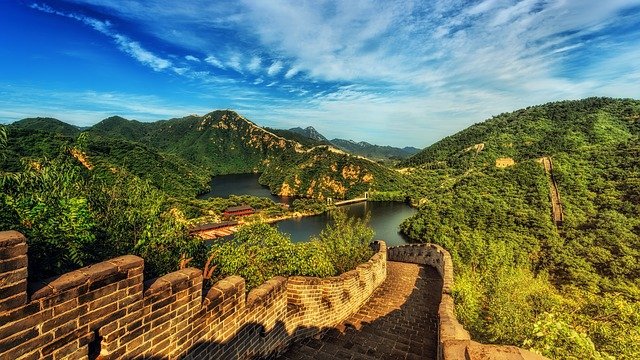
The Great Wall of China remains one of the most fascinating man-made structures in the world and has enthralled people for centuries.
There are still many things that we don’t know about the wall. New sections of it are still being discovered. Further research is being conducted to find more about its past. People are also working together to save it in the present. This marvel of engineering won’t last forever if people don’t pay enough respect to it and to the people who lose their lives to build it.
Tourists and the government alike should work together to preserve the structure. It is fascinating to think about how it has survived millennia, wars, earthquakes, and revolutions. With enough care, we can preserve it for the generations after us to marvel at.





